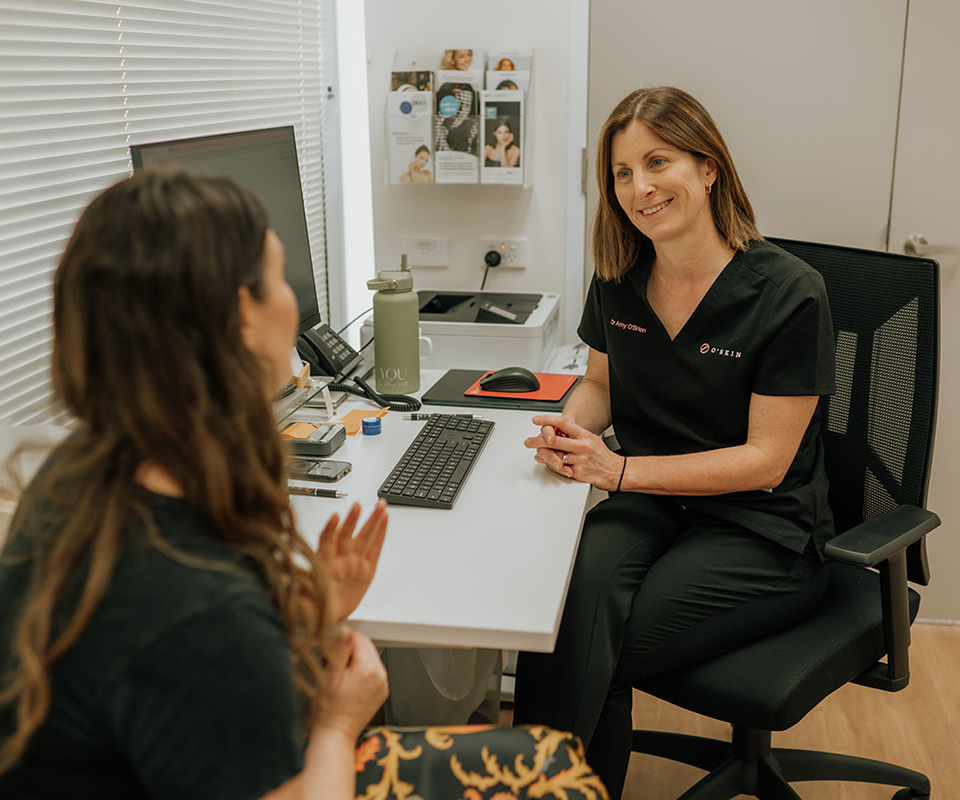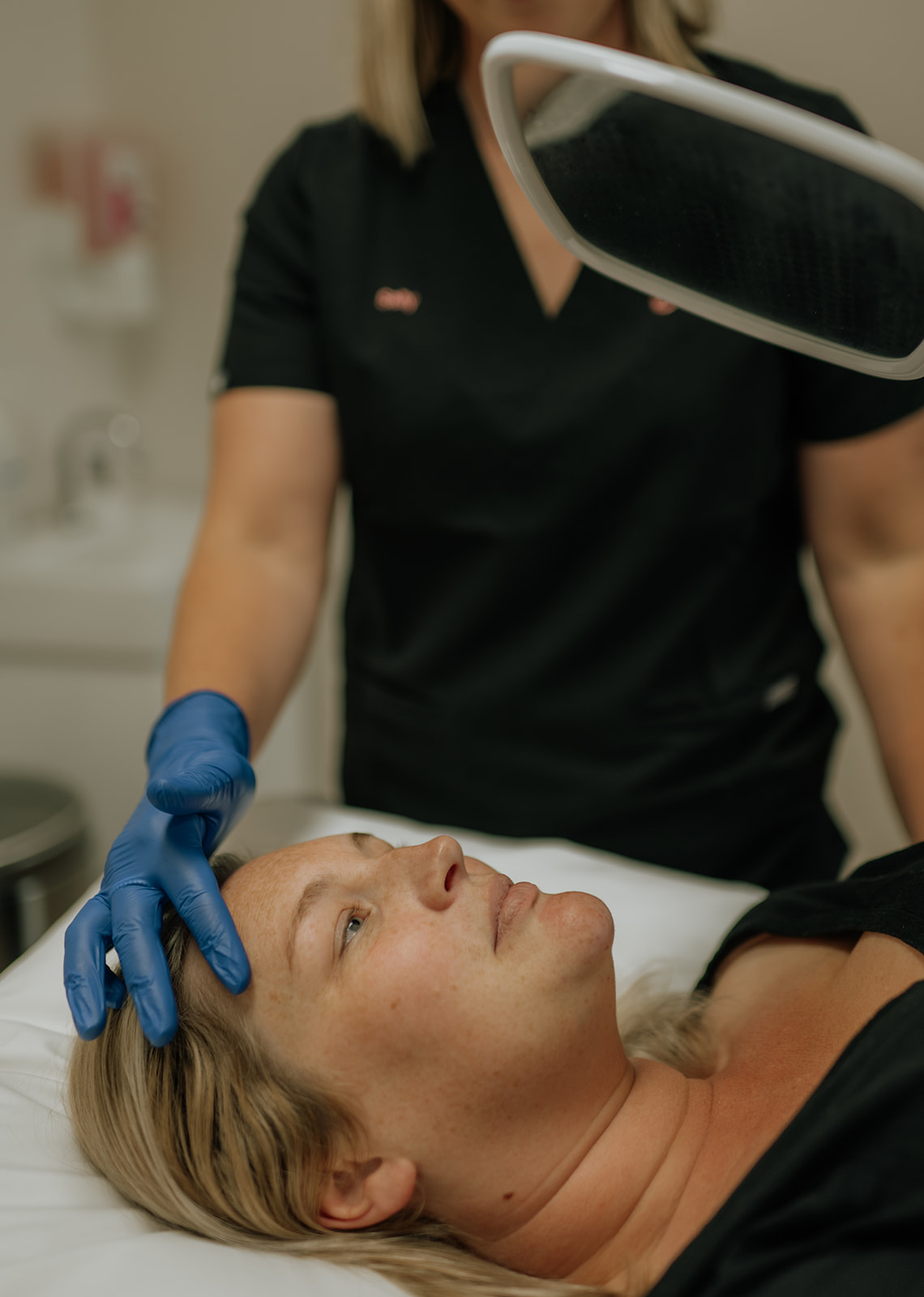Chemical Peels
Chemical peels, also known as enzyme treatments, are a popular treatment designed to improve the appearance of your skin. By applying a specially formulated chemical solution to the skin, a peel can remove damaged outer layers, revealing fresher, smoother, and rejuvenated skin underneath. Chemical peels are effective for a range of skin concerns and can be customised to your specific needs. Gentler peels are safer for sensitive or darker skin to avoid hyperpigmentation and are also a good option for a gentle rejuvenation or maintenance of skin quality. Stronger peels can target more specific concerns such as acne, blocked pores, sun damage, pigmentation and wrinkles. These require more downtime and aftercare. Our dermal therapists will review your skin and skin concerns to choose the right peel for you.

What can a Chemical Peel help with?
Acne and Acne Scarring
Chemical peels help unclog pores, reduce inflammation, and fade post-acne scars, promoting
a smoother complexion.
Hyperpigmentation and Sun Damage
Peels can lighten dark spots, melasma, and uneven skin tone caused by sun exposure or hormonal changes.
Fine Lines and Wrinkles
By stimulating collagen production, chemical peels can minimise the appearance of fine lines and wrinkles for more youthful-looking skin.
How it Works


Initial Consultation
You may have already had a consultation with Dr Amy O’Brien to determine a skin management plan, or this may be your first time in our clinic. Either way, a chemical peel is often the first step in your skin care journey. Dermal therapists Mel and Reanna will discuss your skin care goals on the day of treatment and discuss which is the most appropriate peel for your skin type and concerns.
There are many types of chemical peels – and your consultation can range from a relaxing, pleasant experience to a more intense treatment which can sting and cause you to need some down time.
Treatment
Your skin is cleansed to remove makeup, oils, and impurities. A chemical solution is applied evenly across the treatment area and is left on for a specified duration, depending on the peel type and depth. The solution is neutralised or removed, and you experience our Medilux LED light therapy to help calm the skin afterwards. Soothing aftercare products and sunscreen are applied.
Treatments are 50 minutes in length. Make up can be applied following gentle peels and you can carry on with your day, making them convenient for most schedules.
Aftercare
Proper aftercare is essential to achieve the best results. Keep your skin hydrated with a gentle moisturiser and always use sunscreen with SPF 50. Steer clear of exfoliants, retinol, or strong active ingredients for a few days, until the skin has settled. Allow peeling or flaking to occur without picking or scrubbing. Adhere to any additional guidance specific to your treatment type.
Results can be visible within a week, with ongoing improvements as your skin regenerates.
Frequently asked questions
Why are some treatments not mentioned on your website?
The TGA prohibits direct advertising of prescription-only medications, including injectables, to the public. This includes specific product names, before-and-after images, or promotional claims about effectiveness. Medical professionals are expected to provide balanced, information rather than marketing claims that might mislead consumers. Australian law requires a consultation with a qualified medical professional (such as a doctor or nurse prescriber) before these treatments can be recommended as they may not be the most appropriate option for your concerns. We encourage you to book a consultation with Dr Amy O’Brien or Nurse Sally Logan to find out more, remembering that initial consultations with our nurses are free.
What conditions can be treated with laser therapy?
Laser treatments address tattoos, pigmentation, redness, broken capillaries, angioma, port wine stains, scarring (including acne scars), fine and deep lines, texture, skin laxity, benign skin lesions and more.
Is laser treatment painful?
Patients report varied levels of discomfort, depending on individual tolerance, the laser being used and the settings chosen. For most people laser is tolerable. A topical numbing agent is applied if needed. This will be discussed with you prior to your procedure. Cool compress may also be used during your procedure to help manage any discomfort.
How many sessions will I need for optimal results?
The number varies depending on the laser used, the condition being treated and the settings chosen/tolerated. One session may be required for some issues –such as high-level laser resurfacing, laser assisted PDT, and spot treatments. However, most patients require 3–6 sessions to address their concerns.
What is the downtime for laser treatments?
Downtime depends on the treatment; some have no downtime, while others may require up to 7 days for recovery. Most lasers have little to no downtime, with you being able to continue with daily activities after treatment. We would usually advise you to avoid the sun/use sun protection, avoid physical activity for 24 hours and not to use active skin care until your skin has settled.
What is Rejuran?
Rejuran is a skin rejuvenation treatment that uses polynucleotides, derived from salmon DNA, to repair and regenerate the skin. It is administered through microinjections and works by stimulating collagen production, improving skin elasticity, reducing fine lines, and enhancing hydration. The treatment is commonly used for anti-aging, acne scars, and overall skin texture improvement.
What is a chemical peel, and how does it work?
A chemical peel uses a solution to exfoliate the skin, improving texture, tone, and clarity. Your appointment is 50 minutes in length and includes LED light treatment.
What is microneedling, and what are the benefits?
Microneedling stimulates collagen production to reduce scars, wrinkles, and pores.
What skin conditions can be treated with led light therapy?
LED therapy treats acne, inflammation, and signs of ageing.
Can you treat acne and acne scars?
Yes, we offer a variety of treatments, including laser therapy, peels, microneedling and subcision.
How should I prepare for my treatment?
Follow our pre-treatment guidelines, which may include avoiding sun exposure and certain skincare products. Take antiviral medication if advised to prevent cold sores. Apply numbing cream prior to your appointment if needed.
Can I wear makeup before my appointment?
It’s best to arrive with a clean face, free of makeup.
Are there any medications I should avoid before treatment?
If having ablative laser or any treatment involving injections, blood-thinning medications like aspirin, NSAIDs, St John’s Wort, garlic, gingko biloba should be avoided unless advised otherwise. Patients taking warfarin or a direct oral anticoagulant (DOAC), should have been advised on whether to continue or stop these medications prior to any procedure. If in doubt – please contact O’Skin for clarification.
Can I get treated if I have a tan?
Certain treatments are not recommended for recently tanned skin.
What are the aftercare instructions following laser?
We provide detailed aftercare instructions specific to each treatment.
How long is the recovery period?
Recovery time varies; most treatments have minimal downtime. During your consultation you will be advised if you require down time for any procedure.
Are there restrictions on sun exposure after treatment?
Yes, we recommend avoiding sun exposure and using sunscreen. Whether having a skin treatment or not, you should always be aware of the risks of sun exposure for both skin cancer prevention and ageing effects of UV.
What should I do if I experience side effects?
Contact O’Skin immediately for advice. We are always happy to hear from you, to reassure you about most side effects, or help you manage more serious concerns.
When can I resume wearing makeup or skincare products?
Generally, after 24 hours, but it depends on the treatment. You will be given specific advice after your treatment.
What skincare brands do you recommend?
We recommend and stock AST brands Aspect Doctor and Aspect Sun. We are the sole Tasmanian stockist of premium brand Aspect Platinum.